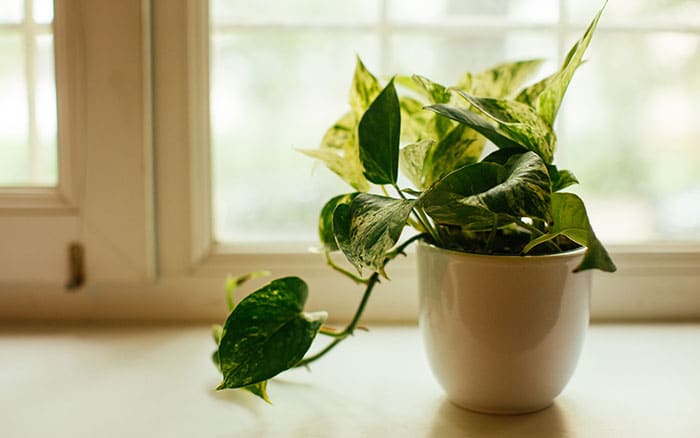Though they’re more commonly known as golden pothos or devil’s ivy, the botanical name for this plant is Epipremnum aureum and it is native to French Polynesia. A popular houseplant, it is easy to care for as it doesn’t demand a lot. So, here’s how to grow devil’s ivy in your home.
Growing golden pothos
The wonderful trailing habit of this houseplant makes it a lovely addition to a bookshelf, windowsill or hanging basket. The heart-shaped leaves have variegated colouring and to keep the colouring looking its best, position this houseplant in a spot with bright but indirect light.
If you’d rather the ivy climbs upwards, place a moss pole into the pot and train the foliage to work its way up.

The common name, devil’s ivy, comes from the fact that it’s so hard to kill. Therefore this is a great houseplant for beginners. It doesn’t demand much, and due to its shallow root system, they don’t need too much water. Water regularly enough to keep the compost moist, taking care to not overwater.
During spring and summer feed with a houseplant fertiliser every two weeks, but reduce to once a month through winter.
Golden pothos prefers an average to high humidity, so don’t place it in a place where the air is particularly dry such as above a radiator.
Repotting devil’s ivy

Again, the shallow root system means golden pothos thrives in a small pot, so they don’t need to be repotted too regularly. This means they can usually be kept in the pot they are bought in for some time. However, if you want more vigorous growth, you can repot it into a slightly larger pot.
When repotting, use a potting mix that is peat-free, well-drained like this Premium Houseplant Potting Mix.
Keep it looking its best by pruning to control the shape and growth. Stems can grow that look pretty bare, so trimming these back will ensure the plant looks dense.
Propagating devil’s ivy
Not only is this houseplant easy to care for but they are also very easy to propagate.
Simply snip off part of the vine and place it in water to root. Ensure you remove the lowest leaves so there aren’t any leaves submerged in the water. Placing it in a glass, tube or jar will allow you to see the magic happen as the roots begin to grow from the leaf nodes.
With these propagation tips you can increase your stock of devil’s ivy for your home and to give to friends and family.


Leave A Comment